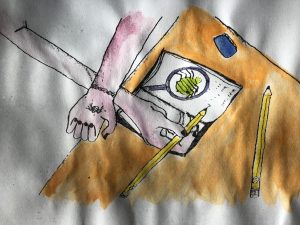Come into the Garden, Maude

To view the photo-rich magazine version, click here.
Originally appears in the Spring 2020 issue.
By John Paull
Editor’s Note: What follows is a journal entry that was made in the summer of 1967 at the end of an environmental education workshop with forty teachers. John sent it to me just as coronavirus-provoked lockdowns began to firmly take hold across most of North America. Now many weeks into this unsettling moment in our history, I realize that John’s piece came to me at precisely the right moment. With educators physically-distanced from their students (in some cases completely isolated from them), there is a great deal of time for reflection. This practice is, of course, a lynchpin of teacher education as well as ongoing professional development of any kind. By its nature, reflection involves looking back into the past, whether recent or distant, and making a mental note to keep the “good” and either adjust or discard the “bad.” Needless to say, this article is an example of the former, and a particularly relevant one in our current situation of limited access to zoos, nature centres, and major parks. In order to get hands-on with nature, many of us are confined to our own gardens or small patches of green in our neighbourhoods. And that’s okay so long as each of us re-orients our lens to a smaller scale. I’ll let John take it from here…
-IS
The other day, a reception teacher from Glasgow was telling me about the little girl who, when asked to draw a long, wriggly worm, said, “I’ve never seen a worm.”
We all know one or two apocryphal stories that make pointed statements about children’s unawareness of the natural world. There is the story of the boy who was flabbergasted on his visit to the farm where he saw a cow being milked. His only experience of milk was in bottles delivered by the milkman each morning.
This is not so surprising. If you live in a high-rise flat, you don’t have many encounters with worms or cows. But, so what? Would it matter if those children grew up not knowing about the cow and the worm? What relevance have the activities of cows and worms to the urban child who lives in a concrete environment. Are the children in schools and homes close to the wild countryside better informed? Is it not a case of recognising small creatures and plants but not knowing them? Surely, it is important that all children have the opportunity to experience the natural world first-hand and learn about familiar living things that share our world with us.
As teachers, we would all agree that if we are able to predict the effects of our activities on the environment, we need to know about the natural processes which sustain life on Earth. Our present-day farm crops and domesticated animals were derived from wild ancestors. With an ever-increasing human population dependent upon shrinking resources, a knowledge of wild plants and animals may become crucial — for food, medicines, and energy sources.
This content is restricted to subscribers only.
If you are not yet a subscriber, please consider taking out a subscription here.
If you are an existing subscriber, kindly log in or contact us at info@greenteacher.com for more information.










